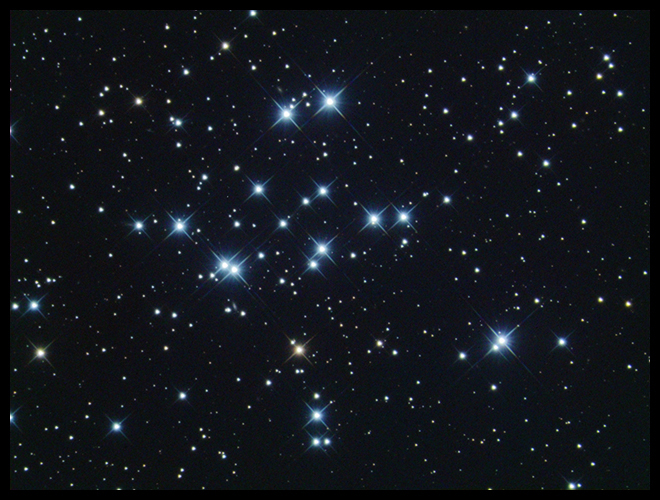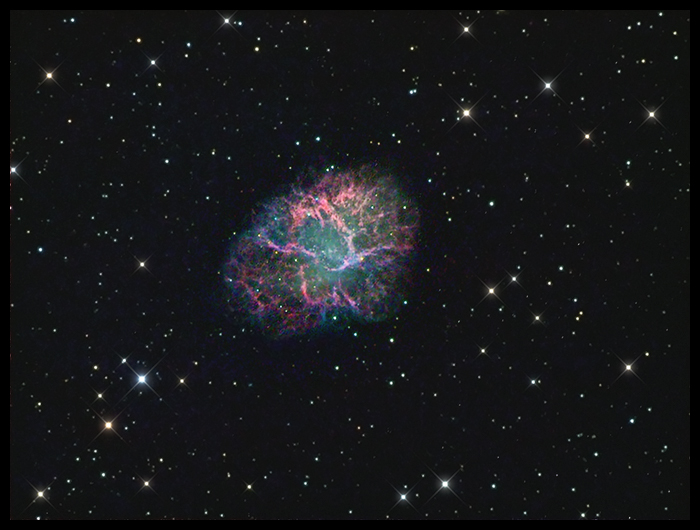12/03/2011. Ever notice that I sometimes post photos made while I'm working with metal but I seldom do so when wood is the material d'jour? There's a reason. With metal, I vaguely know what I'm doing. It's thoroughly predictable. Plus I can borrow some of the romance of the machine from 19th century technology -- there's a steam-punk vibe I can work with. But wood and me... that's just a dolt with something sharp and dangerous. In the end, as long as things fit, more or less, and only a tolerable amount of blood is lost, that's all I ask. It's an ugly process. But! The refractor with its newly-mounted RoboFocus motor rests in its case again, and I was not badly injured getting it there. Got away with it again.
I tweaked collimation a little last night. Reduced stars from 1.8 to 1.4 arc seconds FWHM during focusing runs, which is a way more substantial improvement than I expected. I did this the old fashioned way: watching out of focus donuts and twisting collimation bolts. I was not fanatical about it, either. Since I'm going to be un- and re-mounting the R-C while installing the azimuth adjuster on the mount, I saw little reason to go full-tilt last-micron computer-assisted righteous about refining collimation. It'll just get knocked around in a week or so anyway. I think the order of refinement will be: polar alignment, collimation, gear mesh, airflow. I'll try to be disciplined enough to do them one at a time, a few sessions apart, in order to see what the real effects of each are.
The overnight returns: a faint nebula, a bright cluster, an intricate supernova remant. I'm not convinced that practice makes perfect, but practice and incremental refinements do make better.

vdB141, revisitted. I added color data (3x900s RGB) while we watched Beginners, then piled up more L (5x900s) until the field sank too low for more. It's a faint and discouraging field with vicious color gradients and I may decide this is the best it's going to be until it comes back around and I learn some more about this sport. This image uses all the luminance data available going back several days, including the original N/S frames. Total luminance is 9h45m (29x900s + 5x1800s).

M34. 1x300s RGB, 12x300s L. Note that a couple of wee galaxies peek through the stars. I haven't found these catalogued, but others nearby are of similar brightness (16 - 17) and are said to be about 300,000,000 light-years away. So their light is about the same age as the young stars of this cluster which are a few hundred million years old, but only about 1,800 light-years away. Dizzy yet? I touched up collimation prior to taking this data. I think that improvement shows up better in the next frame than in this one.

M1, the Crab Nebula. 1x900s RGB, best 7 out of 10 1800s exposures through the 7nm hydrogen-alpha filter. Transparency suffered in the middle of the run and including those three frames significantly increases noise. This image lives very far to the left of the histogram, way down in the shadows. I'm not so sure that this one is better than my previous best effort; but it's not bad given such a short luminance exposure (3h30m). The double star in the center, one component of which is the pulsar itself, is not as well seen tonight as before. I sweetened the star-spikes a tidge to make up for the aggressive treatment the natural ones received while I tried to pull filaments and color and soft inner glow all out at the same time. [12/4: I added all my previous Crab data and compared. Actually, the data filet above is better. Most aspects are considerably sharper. I think it's because longer, deeper exposures don't reveal additional details in this case, and the details that are visible are well shown with 3.5 hours of exposure. Adding 8 or 9 more hours of equal or inferior data just adds noise. So sometimes more isn't more, after all.]
You know how people always ask, "What's the power" of your telescope? Maybe not so much now as a few years ago, when telescopes were more of a retail item. They always mean or meant, "How much does it magnify?" I suppose a reasonable answer for the 2000mm R-C on the ST2000XM CCD would be to look at it as the equivalent of a 6000mm lens on a 35mm camera. So the answer is something like 6000/50 or 120x. That would be more useful if we were talking about a microscope. With a telescope, the real answer, of course, requires backing up a step and explaining that it's really much more about gathering light than magnification. So maybe I should take note of the faintest objects visible in the frames and compare that to what the eye could see on a decent night. The answer varies by exposure. The vdB141 frame goes to something like 19th magnitude and 2.514^(19-6) = 160,000x. The day-long image of NGC 891 a few pages back reaches to around 21st or even a little deeper, so ~1,500,000x. The shot of M34 above "only" gets down to around 17th; let's say it's about 45,000x.
Except where noted, deep-sky photos are made with an SBIG ST2000XM CCD behind a 10-inch Astro-Tech Ritchey-Chretien carried on an Astro-Physics Mach1GTO. The CCD is equipped with Baader LRGB and 7nm H-a filters. A Meade DSI Pro monochrome camera looking through a modified Orion off-axis guider keeps the OTA pointed in the right direction. The imaging camera is controlled via Nebulosity 2; the guide camera is operated by PHD Guide 1.13, both by Stark Labs. The stock focuser on the AT10RC has been augmented with Robofocus 3.0.9 using adapters turned on the lathe downstairs. Maxim DL5.12 performs image calibration, alignment, and stacking; Photoshop CS4 and FocusMagic 3.0.2 take it from there. Gradient Xterminator by Russell Croman and Astronomy Tools by Noel Carboni see their share of work, too.
:: top ::